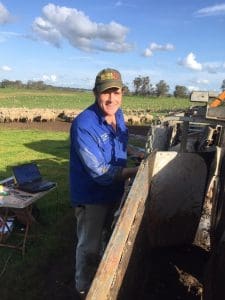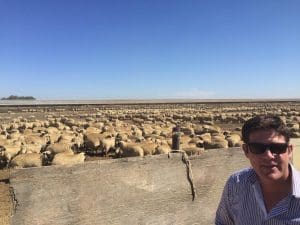
Nuffield scholar Michael Craig at home on ‘Tuloona’, at Harrow.
EBAY for prime lambs – Baa-Bay — as Nuffield scholar Michael Craig calls it, with animals assessed on-farm for meat yield and eating quality, could underpin a future Australian value and cuts-based sheep meat marketing system.
And mandatory electronic identification of sheep and lambs, as initiated in Victoria, might be the disruptive transformation to break the culture of producers and processors conditioned into determining prices based predominantly on supply to saleyards or direct to abattoirs.
The south-west Victorian sheep, wool and beef farm manager from Harrow, west of Melbourne, last week reported to the annual Nuffield Conference on his two-year comparative investigation into ‘supply chain value transfer’ in sheep meat marketing systems in Australia, America, the United Kingdom, Europe, and New Zealand.
He wanted to understand the enablers and ‘disenablers’ of moving from a supply-based to value-based chain, the options for improving vertical co-ordination within Australia’s sheep meat supply chain and to look at transparent price discovery mechanisms that incentivised value-creation behaviours and built trust.
Pricing signals must evolve around eating quality

Nuffield scholar Michael Craig at one of America’s biggest feedlots at Dixon in California — 50,000 lambs annually.
Mr Craig concluded that for the Australian sheep meat industry to build its reputation for quality and further differentiate itself in world markets, it is imperative the sector’s transaction and pricing signals evolve around measurable eating quality attributes.
According to ABARE statistics more than 60 percent of Australia’s sheep and lambs are sold through saleyards, a system valued for its spot market price discovery and transparency, but which Mr Craig regarded as “a mob-based averaging approach for processors where prices are set on fair average quality which sets our price indicator, the Eastern States Trade Lamb Indicator.”
“This transaction and price setting mechanism has a long traditional history and it has worked well to provide processors with supply and a simple method for producers to ensure maximum perceived competition.
“The challenge for industry now is whether this system is the best long term mechanism for creating a quality-focussed industry,” he said.
Virtual price discovery system challenge is trust
Mr Craig said online platform AuctionsPlus currently accounts for 8 percent of the sheep and lambs traded in Australia, although 85pc of these were store animals traded between producers.
“The system of AuctionsPlus does provide vendors with improved flexibility, as animals can be reoffered if they don’t reach specified reserves.
“Whereas saleyards tend to force producers to become a price taker as they become a captive seller, rarely do producers bring their animals home, because of increased cost and biosecurity risks, “ he said.
“The challenge for a virtual price discovery mechanism is trust — trust and confidence in the current subjective nature of the measurements of the animals and as many producers have mentioned, the saleyards do offer the simplicity of acting as a collection centre once a week for a multitude of different types of animals for different users.”
This is where his idea of mobile scanners measuring saleable meat yield and eating quality comes in, with the advantage of maintaining producers’ freedom to sell or not sell through a “virtualised price discovery mechanism.” He said the pork industry has some capability for live assessment of meat yield and eating quality, but he would like to see more research on this in the sheep industry.
“What if these issues could be partially solved if animals could be easily objectively measured for their saleable meat yield and eating quality on farm, and then sold on farm, not eBay, but Baa-Bay?” Mr Craig said.
“This would require a monumental shift in coordination within the transport system and the third party agents, as well as a cultural/behavioural change for both producers and processors.”
AuctionsPlus sees value in on-farm eating quality measurement
AuctionsPlus chief executive officer Anna Speer said the online livestock marketer is watching closely the research into meat yield and eating quality measurement in processing plants and was discussing potential on-farm research options with Meat & Livestock Australia.
“I think definitely that’s the future.
“How quickly we get there depends on the technology and whether we can get it to a point where it is cheap and easy enough to utilise (on-farm).”
“Technology, moving forward, is an enabler for us to get more information about the animal, whether it is eating quality, lean meat yield or basic muscle scanning.
“Everything like that helps us know more about that animal on farm, which means we are in a better position to market that animal,” she said.
“Ideally if we were using the same tools on farm as what they are using in a processing facility or in a feedlot, all of a sudden we take a bit of that subjectivity and the potential for misdescription out of the picture.”
Electronic identification can align producers with consumers
Even without Baa-Bay, the Nuffield scholar said Victoria’s “good” decision to mandate electronic identification (EID) of sheep would help lamb producers move to a value and cuts-based marketing and price discovery system and away from mob averaging of the saleyards.
“EID is the link to allow hook tracking and individual carcase pricing, based on saleable meat yield –aligning goals of producers, processors and consumer through pricing signals.
“The continued investment in objective carcase measurement, focussed both on lean meat yield and eating quality metrics is critical,” he said.
“The digital world is coming and the sheep meat industry can continue its success with product differentiation that links back to the farm gate through price signals, which will then incentivise our management and genetics for quicker gain because we get paid for it.
“Producer advocacy groups have to ensure the agenda doesn’t get hijacked by vested interests focused more on their own survival than growing the sheep meat pie.”



Great stuff Michael. Do hope you and as many others as possible, will see fit to contribute to the animal welfare inquiry, as I think that is the big hurdle to making your vision reality.
Congratulations Michael, it is wonderful to see enthusiastic and well-informed young producers challenging the status quo and creating a vision for the future.